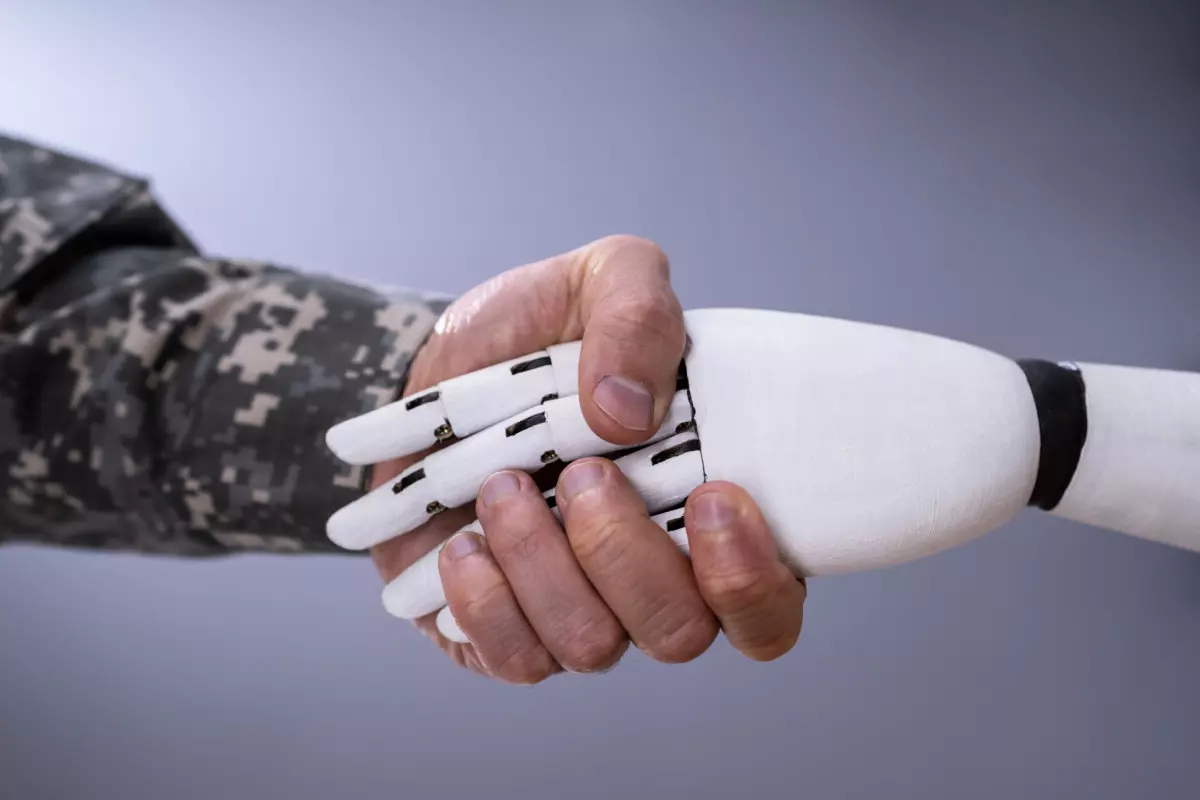AI in the Military: How is Artificial Intelligence Transforming Modern Warfare?
Artificial intelligence (AI) has emerged as a game-changing technology with the potential to revolutionize warfare. The military sector has recognized the immense capabilities of AI and has been actively exploring its various applications.
This article will delve into the futuristic military landscape, explore the advancements in military robots and armor, discuss the latest military technologies empowered by AI, and highlight key takeaways from the evolving field.
Futuristic Military
The concept of futuristic military technology has long fascinated science fiction enthusiasts and military strategists alike. With the rapid advancement of technology in recent years, the idea of soldiers equipped with state-of-the-art gear and weaponry is becoming more of a reality than ever before.
Let’s look at a few ways AI can be used in the military.
Military Robots
Military robots are autonomous machines designed to carry out tasks in the military such as reconnaissance, surveillance, and combat operations. These robots are equipped with AI algorithms to analyze data, make decisions, and complete missions with precision and efficiency.

With the ability to operate in hazardous environments, these robots can keep human personnel out of harm’s way while gathering valuable intelligence and providing support during combat operations. In some cases, these robots can act as force multipliers, working alongside human soldiers to increase a unit’s effectiveness.
Militaries around the world are widely adopting these machines. Countries from the United States to China invest heavily in military robots to gain a strategic advantage on the battlefield. In the U.S., the Pentagon has made significant investments in developing AI-based military robots, including autonomous ground and aerial platforms.
In addition, data shows that the global market for military robots is expected to reach $32.7 billion by 2030. This growth is driven by the increased adoption of AI-powered military robots and the development of new technologies such as autonomous weapon systems and swarm robotics.
Military Armor
In addition to military robots, AI is also transforming the field of military armor. Futuristic military armor integrates AI technologies to enhance protection, situational awareness, and combat effectiveness. These advanced armor systems leverage AI algorithms to analyze incoming threats, optimize defensive measures, and provide real-time feedback to the wearer.
AI-powered military armor is designed to adapt to changing battlefield conditions, making soldiers more agile and resilient. It can detect and neutralize threats, enhance communication capabilities, and provide information to commanders and troops on the ground. This cutting-edge AI technology is set to revolutionize soldier survivability and combat effectiveness.
Latest Military Technologies
The military sector is at the forefront of innovation, constantly exploring and adopting the latest technological breakthroughs to enhance defense capabilities and improve operational efficiency. From autonomous systems and intelligent surveillance to cybersecurity, let’s explore some key advancements in military technology.
Autonomous Weapons Systems
Autonomous AI weapons systems are designed to independently select and engage targets, making decisions without direct human intervention. This technology can potentially revolutionize how militaries conduct war, as they can operate with greater speed and precision than human operators.
Nations such as the United States, Russia, Israel, China, and the United Kingdom are all actively researching and developing AI-powered military robots. The United Nations has also set up a working group to discuss the ethical, legal, and security implications of using such weapons.
The main advantages of autonomous weapons systems are that they can analyze large amounts of data in real-time, enabling them to make rapid decisions on the battlefield. They can also eliminate the risk of human error, as the robots are programmed to follow precise protocols and instructions. However, their use must be carefully regulated, as there are still concerns about the ethical implications of such technology.
Cybersecurity and Information Warfare
AI’s role in cybersecurity and information warfare is expanding rapidly as military operations become more digitized and interconnected. Here are some ways in which AI is making significant contributions to this field:
- Threat Detection and Response: AI-powered cybersecurity systems can monitor networks and identify anomalous activities or potential cyber threats in real-time. By analyzing patterns and behaviors, AI algorithms can quickly detect and respond to sophisticated attacks, including those that may bypass traditional security measures (such as firewalls, antivirus software, and intrusion detection systems).

- Vulnerability Assessment: AI can assist in identifying vulnerabilities in military networks and systems. These vulnerabilities may include network vulnerabilities, software vulnerabilities, insider threats, malware and intrusion detection, and social engineering attacks. It can continuously scan and analyze system configurations, code, and network traffic to identify potential weaknesses that attackers could exploit. This proactive approach helps strengthen defenses and patch vulnerabilities before they can be exploited.
- Behavioral Analytics: AI can analyze vast amounts of data generated by military networks, devices, and applications to establish normal behavioral patterns. Using machine learning algorithms, AI can identify deviations from these patterns that may indicate insider threats or compromised accounts. This allows for early detection of potential threats and helps mitigate risks effectively.
- Threat Intelligence: AI can process and analyze enormous volumes of data from various sources, such as social media, dark web forums, and intelligence reports, to provide actionable insights to intelligence agencies. By detecting trends, correlating information, and identifying potential threats, AI helps intelligence agencies stay ahead of adversaries, anticipate their actions, and formulate effective strategies.
- Cybersecurity Automation: AI can automate routine cybersecurity tasks, such as security monitoring, incident response, and threat analysis. This reduces the burden on human analysts, enabling them to focus on more complex and strategic aspects of cybersecurity. Automation also helps reduce response times, improve efficiency, and minimize human error.
- Adversarial Machine Learning: Adversarial machine learning involves training AI models to recognize and defend against adversarial attacks. By simulating attacks and training AI systems to detect and respond to them, military organizations can better protect their networks and systems from sophisticated adversaries who may attempt to exploit AI vulnerabilities.
- Cyber Threat Hunting: AI can assist in proactively hunting for potential threats within military networks. By analyzing network traffic, logs, and other data sources, AI algorithms can search for indicators of compromise or emerging threats that may go unnoticed by traditional security measures. This helps in identifying and neutralizing threats before they cause significant damage.
Drone Technology
Drones, also known as unmanned aerial vehicles (UAVs), have become a key component of modern military operations, and advancements in drone technology are being driven by AI algorithms.
These algorithms empower drones to operate autonomously in complex environments, perform tasks such as target identification, and conduct surveillance missions with a high level of precision. As a result, AI-powered drones are transforming how military forces gather intelligence and carry out precision strikes.
One of the key capabilities that AI brings to military drones is autonomous navigation. Drones can use AI algorithms to navigate through intricate and challenging environments without constant human control.
Advanced computer vision and sensor systems enable drones to detect and analyze their surroundings, avoiding obstacles and planning optimal flight paths. This autonomy allows drones to operate efficiently and safely in diverse terrains, expanding their usability in military operations.
AI-powered drones also excel in target identification and tracking. By leveraging computer vision algorithms, drones can analyze visual data in real-time and accurately identify objects, individuals, or specific patterns of interest.
This capability is particularly valuable in reconnaissance missions and target acquisition, providing military forces with actionable intelligence. Drones equipped with AI algorithms can track targets with high accuracy, enhancing the effectiveness of military operations.
Furthermore, AI empowers drones with the ability to conduct surveillance missions and provide situational awareness. Equipped with AI algorithms for object detection, anomaly detection, and behavior analysis, drones can monitor vast areas in real-time.
This enables them to identify suspicious activities, monitor critical infrastructure, and provide up-to-date situational awareness to commanders and ground troops. By leveraging AI, drones become valuable assets in enhancing military intelligence capabilities.
While AI-powered drones bring significant advancements to military operations, they do not eliminate the need for human direction in planes, submarines, and other military vehicles.
Instead, they augment human capabilities and provide enhanced situational awareness, intelligence gathering, and precision strikes. The role of people in the military will evolve to focus on interpreting the data collected by AI systems, overseeing and controlling AI-powered systems, and ensuring ethical use.
Key Takeaways
- AI is revolutionizing warfare by enabling the development of military robots and advanced armor systems.
- Military robots equipped with AI algorithms can perform a variety of tasks, from reconnaissance to combat operations.
- AI-powered military armor enhances the protection, situational awareness, and combat effectiveness of soldiers.
- Autonomous weapons systems, cybersecurity, information warfare, and drone technology are key areas where AI is transforming military operations.
- Responsible development and deployment of AI technologies in the military are key to addressing ethical, operational, and strategic risks.
Sum Up
The integration of AI in the military is transforming the way armed forces operate and conduct warfare. From military robots and advanced armor systems to autonomous weapons and drone technology, AI enables unprecedented capabilities and reshaping the battlefield.
As technological advancements accelerate, military organizations are given more options for strategic advantages.
Try our real-time predictive modeling engine and create your first custom model in five minutes – no coding necessary!
- Fully operational AI with automated model building and deployment
- Data preprocessing and analysis tools
- Custom modeling solutions
- Actionable analytics
- A personalized approach to real-time decision making



